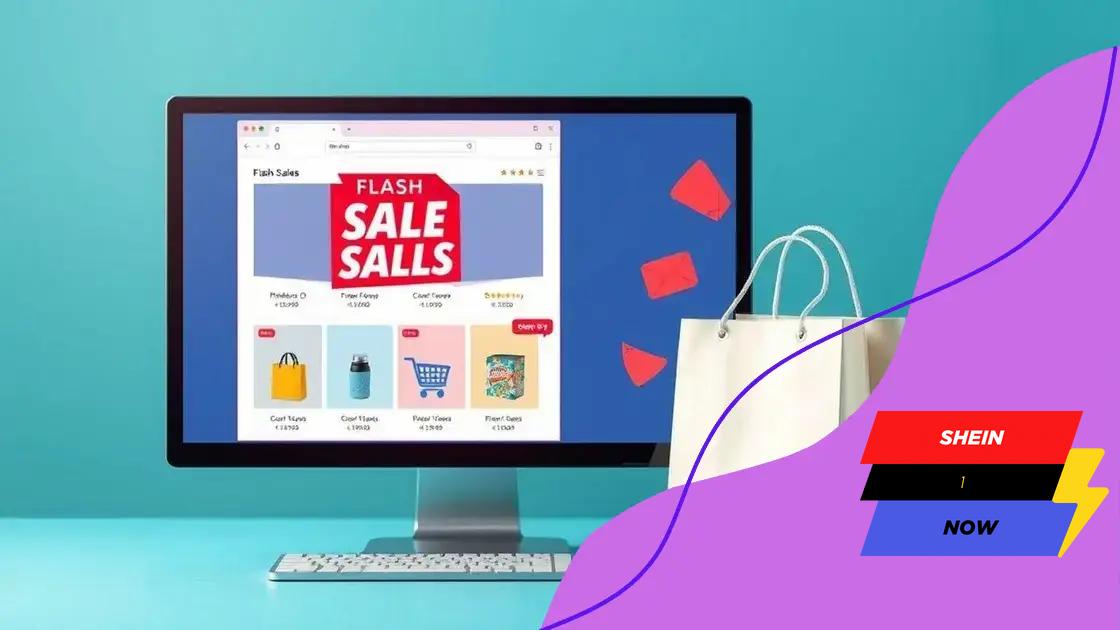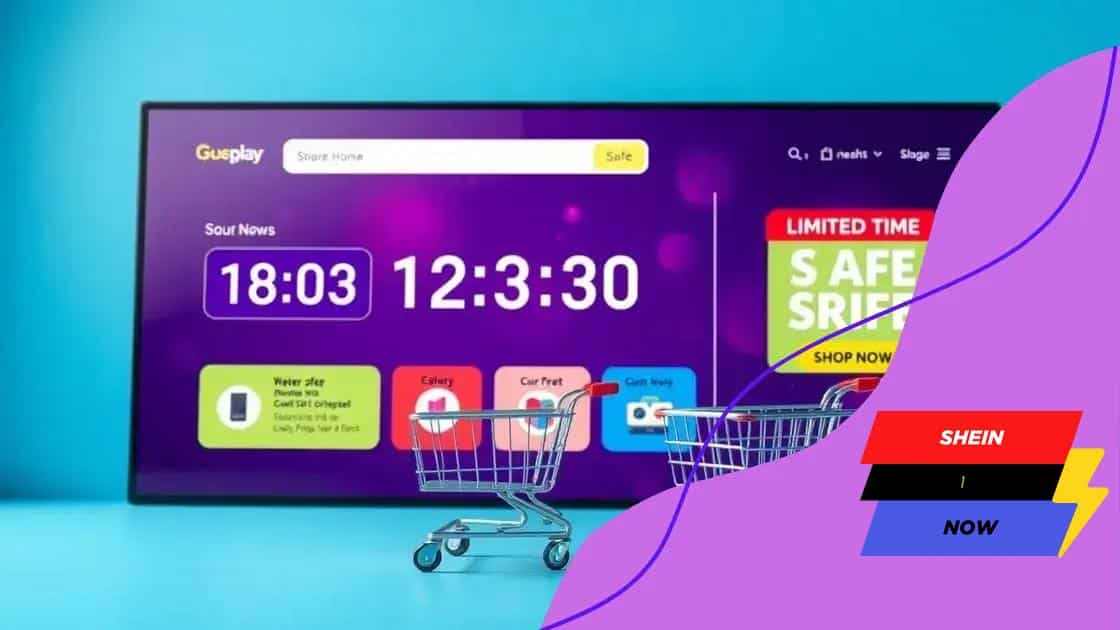The economics of Shein’s flash sales: a closer look

The economics of Shein’s flash sales involve strategies like urgency, dynamic pricing, and effective supply chain management to drive consumer behavior and boost sales while navigating challenges such as inventory management and customer experience.
The economics of Shein’s flash sales is a fascinating topic that dives into how this fast-fashion giant keeps customers engaged and coming back for more. Have you ever wondered why these sales are so effective? Let’s explore!
Understanding Shein’s pricing strategy
Understanding Shein’s pricing strategy is essential for grasping how this brand stays competitive in the fast-fashion market. By continually adjusting prices and employing various tactics, Shein ensures that customers feel they are getting a great deal while also maximizing profits.
Dynamic Pricing
One of the key elements of Shein’s pricing strategy is the use of dynamic pricing. This means that prices can change based on demand, seasonality, and inventory levels. By monitoring customer behavior, Shein can quickly adjust prices to attract more buyers and encourage sales.
Discounts and Promotions
Another crucial aspect is the frequent discounts and promotions offered. Shein often runs flash sales that create a sense of urgency among customers. This not only boosts sales but also keeps the brand fresh in the minds of consumers.
- Limited-time offers to increase purchase urgency
- Exclusive discounts for app users to drive mobile sales
- Seasonal sales to clear out older inventory
These strategies are designed to create excitement and encourage shoppers to complete their purchases quickly. Furthermore, Shein relies on a strong online presence, making it easy for customers to access deals quickly through social media and email marketing.
Psychological Pricing
Shein also employs psychological pricing techniques, such as ending prices with .99 or .95. This tactic makes items seem less expensive, enticing customers to buy more. When shoppers see a price like $19.99 instead of $20.00, they perceive it as a better deal, even though the difference is minimal.
Additionally, Shein frequently introduces limited edition collections and exclusive items that create a ‘fear of missing out’ among customers. This urgency can drive shoppers to purchase items they may not have initially considered. With effective marketing and targeted promotions, Shein cultivates a loyal customer base eager for the next shopping opportunity.
Understanding these strategies helps customers make informed decisions while shopping and allows them to spot the best deals as Shein continues to innovate their pricing methods.
The impact of flash sales on consumer behavior
The impact of flash sales on consumer behavior is significant and worth exploring. These short-lived promotions create a unique shopping experience that affects how customers interact with brands and make purchasing decisions.
Urgency and Scarcity
Flash sales tap into psychological triggers such as urgency and scarcity. When shoppers see a time-limited deal, they feel an increased pressure to make a purchase before the opportunity disappears. This sense of urgency often leads to impulse buying, where consumers purchase items they may not have intended to buy.
Increased Engagement
Moreover, flash sales draw customers’ attention in a crowded marketplace. When offered, customers tend to engage more with the brand, whether it’s through social media, emails, or the website. This heightened engagement can build brand loyalty over time.
- Flash sales encourage sharing on social media for broader reach.
- Increased traffic to websites during these sales boosts overall visibility.
- Engaged customers often return for future promotions and regular shopping.
Shoppers become more attentive to brand announcements as they anticipate the next sale, creating a cycle of interaction that benefits both the customer and the brand.
Price Sensitivity and Brand Perception
Flash sales also impact how consumers perceive prices. Shoppers may become more price-sensitive, interpreting regular prices in the context of discounts. This habit can lead consumers to only consider buying during sales, affecting overall purchasing patterns.
As consumers begin expecting these frequent sales, brands like Shein must be careful not to devalue their products. If customers only associate the brand with flash sales, the perceived value can diminish.
The strategic use of flash sales by brands influences consumer habits, leading customers to wait for sales rather than making full-price purchases. This behavior promotes a cycle of discount-driven shopping that brands must balance carefully.
Marketing tactics that drive urgency

Marketing tactics that drive urgency are essential for brands like Shein to increase sales and boost customer engagement. These strategies create a sense of immediacy, compelling consumers to take quick action before the opportunity passes.
Limited-Time Offers
One widely used tactic is limited-time offers. By showcasing deals that last for only a few hours or days, brands create a feeling of urgency. Customers feel they must purchase items quickly, fearing they might miss out on great savings.
Countdown Timers
Another effective method is the use of countdown timers on product pages. When customers see a ticking clock, it can trigger their desire to act before time runs out. These visual cues reinforce the urgency of the promotion and encourage quicker purchasing decisions.
- Highlighting best-selling products available for a limited time.
- Offering flash sales that change daily to keep shoppers returning.
- Exclusive discounts for the first few customers who check out.
Incorporating these elements not only boosts sales but also enhances customer satisfaction as they feel they are getting the best possible price.
Scarcity Marketing
Scarcity marketing is another powerful approach. When brands highlight that only a few items are left in stock, it pushes consumers to buy before the product runs out. Messaging like “Only 3 left!” creates an emotional response that can lead to rapid purchases.
Through these strategies, Shein successfully drives urgency and increases conversion rates. Consumers are often looking for the thrill of a good deal, and these marketing tactics effectively cater to that desire. The combination of scarcity and urgency creates an engaging shopping experience that frequently results in impulse purchases and higher sales.
Supply chain efficiency in flash sales
Supply chain efficiency in flash sales is crucial for brands like Shein to meet consumer demand swiftly and accurately. A well-optimized supply chain allows for quick turnaround times, ensuring that products are available when customers are eager to purchase.
Real-Time Inventory Management
One key to achieving supply chain efficiency is real-time inventory management. By tracking stock levels continuously, brands can determine which items are most popular during flash sales. This data helps in restocking items quickly and avoiding missed sales due to out-of-stock situations.
Logistics Optimization
Logistics also plays a significant role. Efficient logistics systems enable fast shipping and accurate order fulfillment. By partnering with reliable logistics providers, brands can streamline delivery processes and enhance customer satisfaction. When shoppers see that items are shipped quickly, they are more likely to return for future purchases.
- Utilizing advanced tracking systems to monitor shipments.
- Partnering with local warehouses for faster fulfillment.
- Offering multiple shipping options to meet customer needs.
Additionally, the ability to quickly adapt to changing demand patterns is vital. For instance, if a particular product sells out rapidly, Shein’s supply chain must respond quickly to replenish stock to keep customers happy.
By leveraging technology and data analytics, companies optimize their supply chains to prepare for flash sales. Investments in automation and AI can predict trends and streamline processes further, which is essential in today’s competitive market.
Ultimately, a strong supply chain not only supports flash sales but also helps establish a brand’s reputation for reliability. When consumers can trust that their orders will be fulfilled efficiently, they become repeat customers.
Risks and challenges of flash sales models
Risks and challenges of flash sales models are important for brands like Shein to understand. While flash sales can drive significant revenue, they also come with potential pitfalls that can impact long-term success.
Over-Reliance on Promotions
One major risk is the over-reliance on promotions. If a brand continually offers flash sales, customers may begin to expect discounts as the norm. This can lead to a decrease in perceived value, making it harder to sell products at full price in the future.
Inventory Management Issues
Another challenge involves inventory management. Flash sales can lead to a sudden spike in demand, causing brands to struggle to keep up. If products run out too quickly, customers may feel disappointed, which can harm brand loyalty.
- Balancing supply and demand effectively.
- Avoiding stockouts or excess inventory post-sale.
- Implementing effective forecasting methods.
Additionally, during these high-stakes events, logistical challenges can arise. If shipping times are longer than expected, it may lead to negative reviews and hurt customer satisfaction. Managing logistics efficiently during flash sales is essential to ensure timely delivery.
Customer Experience Concerns
Flash sales may also create an overwhelming shopping experience for consumers. When too many buyers compete for limited products, it can lead to website crashes or slow load times. These technical issues can frustrate shoppers and drive them away from the brand.
Moreover, aggressive marketing for flash sales can sometimes lead to backlash. Customers may feel manipulated into making quick purchases and see it as a low-quality shopping experience. Maintaining a positive relationship with consumers is crucial to avoid this perception.
In summary, while flash sales can be a powerful tool for brands, they must also navigate the inherent risks and challenges. By managing inventory effectively, ensuring a seamless customer experience, and avoiding over-reliance on discounts, brands can enhance their flash sale strategies for greater success.
FAQ – Frequently Asked Questions about Flash Sales and Supply Chain Management
What are flash sales?
Flash sales are limited-time promotions that create urgency for customers to buy products quickly before the sale ends.
How do flash sales impact consumer behavior?
Flash sales encourage impulse buying by creating a sense of urgency and scarcity, leading customers to make quicker purchasing decisions.
What are the risks of relying too much on flash sales?
Over-reliance on flash sales can devalue products, lead to inventory management issues, and negatively affect customer expectations.
How can brands manage supply chain challenges during flash sales?
Brands can optimize supply chains by using real-time inventory tracking, improving logistics, and ensuring a smooth customer experience.





